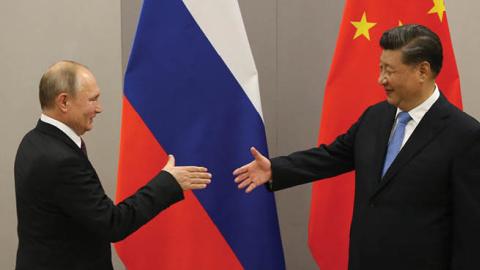Chinese President Xi Jinping hosted Russian President Vladimir Putin at the Beijing Olympics. In a joint statement, the two said that “friendship between the two states has no limits” and “there are no forbidden areas of cooperation.”
The statement was striking for its clarity, but it should not come as a surprise. The systematic interplay between Russia and China’s aggressive revisionist strategies has been especially visible for the last several years. The threat of a new Russian invasion of Ukraine has now brought the de-facto alliance into sharp relief. U.S. policy, however, still does not reflect this reality.
China and Russia coordinated last week to block the UN Security Council's session on Russia's threats toward Ukraine. Days before, U.S. official Victoria Nuland had called on Beijing to use its influence with Moscow to push for diplomacy, noting that a conflict in Ukraine would not be good for China. But in a phone call with U.S. Secretary of State Antony Blinken, the Chinese foreign minister parroted Putin’s pretext for an invasion. This follows a pattern.
Points of Cooperation
After the United States withdrew from the Intermediate-Range Nuclear Forces Treaty in 2019 owing to Russian violations, China objected and forebodingly warned of “negative consequences.”
During their virtual meeting in December 2021, Putin and Xi denounced AUKUS and the Quad, two security architectures aimed at deterring China and increasing allied collaboration for a free Indo-Pacific. Putin also declared Xi’s claims on democratic Taiwan to be legitimate.
China has participated in large-scale Russian military exercises, including Zapad 2021. That exercise, which translates to “West,” involved a substantial Russian presence in Belarus as well as interaction with Russian forces in the Kaliningrad exclave. It also led to the creation of the 18th Motorized Rifle Division in Kaliningrad. The division would be a key unit if the Russians decide to exploit their troop presence in Belarus and breach the Suwalki Gap—the land corridor between Poland and Lithuania.
China-Russia military cooperation also extends to rogue nations: to Iran, including joint military exercises, and to North Korea, by increasing the extent of military supply and technology.
At the same time, both revisionist countries are in the midst of significant military build-ups, and most alarmingly, nuclear weapons advances. Even though Putin and Biden extended the New START Treaty, which capped deployed intercontinental-range nuclear systems, Russia has more than 2,000 theater-range nuclear weapons unconstrained by the treaty. Moscow has nearly completed a full overhaul of its nuclear weapons, and it has deployed nuclear-capable missiles to Kaliningrad.
China is also dramatically expanding its nuclear arsenal. Beijing’s overhaul features the full triad of delivery systems and emphasizes theater systems. China could quadruple its number of nuclear warheads in a decade.
Despite their investments in defenses and expansive arsenals of dual-capable strike systems, the joint statement specifically objected to U.S. missile defense deployments “combined with capacity building of high-precision non-nuclear weapons for disarming strikes and other strategic objectives.”
Resetting U.S. Priorities
Pentagon officials have said that “competing” with China is the priority. At times, the Biden administration has used competition with China as a pretext for disengagement elsewhere or for making concessions to Russia. This makes no sense when considering the de-facto Sino-Russian alliance.
Biden defended his decision to stick to the Afghanistan withdrawal, mentioning that it was at least in part meant to help focus on China. Likewise, he withdrew missile defense systems from the Middle East, failing to appreciate how Iran’s proxy wars benefit China and Russia. The Biden team also believed that blocking sanctions on Nord Stream 2 might improve relations with Russia. None of these have had their intended effect.
Furthermore, a leaked report revealed that as part of an effort to convince Russia to not invade Ukraine, the Biden team has offered to negotiate an arms control deal that would allow Russia to conduct on-site verification that missile-defense sites in Poland and Romania cannot launch cruise missiles. The deal was offered in exchange for similar measures in Russia. This is essentially a new INF deal, and it has been put forth despite Russia’s continued lies about its deployments and previous violations. It would effectively reward Russian threats of aggression against NATO with a promise to keep NATO countries less able to defend themselves. This would expose the U.S. to accusations of violations if it produces these weapons for the Pacific.
A realistic policy means adjusting America’s strategic vision. This starts with the new National Defense Strategy, Nuclear Posture and Missile Defense Reviews. Expected this month, these three strategies must recognize the growing alliance between Russia and China. They must seek to frustrate it not through bilateral arms control and other concessions, but by investing in, producing, and deploying the right weapons systems, cooperating with U.S. allies to deter China and Russia’s revisionist aims.
On strategic deterrence we must invest in advanced conventional strike weapons and set out a robust and visible test program. Instead of an INF-like agreement with Russia, the United States should produce missiles of intermediate range and work toward deploying them in Europe and the Pacific.
Our nuclear deterrent, likewise, must receive full investment so that it can flexibly adapt as needed. This must include the low-yield systems the previous administration added. Restricting U.S. nuclear deterrence through policy statements, modernization delays, or cancellations is unwise in the extreme.
Despite Biden’s longtime effort to roll back missile defenses, and the Russian and Chinese insistence that the United States limit our defenses, today’s unpredictable environment calls for more. Deterring two major nuclear powers and rogues might not always work as we hope. Meanwhile, North Korea is taking advantage of a distracted America by testing ballistic missiles, and Iran continues to arm its proxies to target U.S. partners in the Middle East. Iran is also advancing its ICBM program through its space program.
The Biden administration should strengthen and adapt NATO, whose footprint has not changed since 1945. The Russian aim is to absorb the sovereign nations that were formerly in the Soviet Union into a modern Russian Empire. NATO’s front line should be moved from the Fulda Gap to the Suwalki Gap. Relatedly, the Biden administration must revert to opposing Nord Stream 2 and be willing to sanction Germany if it persists with the pipeline.
The Biden administration’s desire to deter China while cutting defense spending doesn’t work. And Washington’s attempts to only compete with China while improving relations with Russia and disengaging elsewhere have failed. Putin has stood with Xi at the Olympics, and the answers to the questions about the fate of Ukraine and Taiwan might be decided there. It is time to face the reality that we have two major nuclear powers working together to undermine the West. We must adapt, and quickly.
Read in RealClear World
















